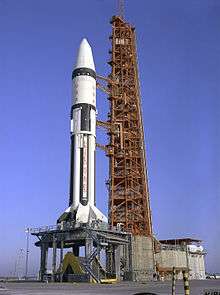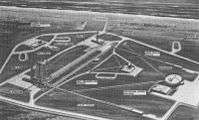Cape Canaveral Air Force Station Space Launch Complex 37
|
| |||||||||||||||||||||||
| Launch site | Cape Canaveral Air Force Station | ||||||||||||||||||||||
|---|---|---|---|---|---|---|---|---|---|---|---|---|---|---|---|---|---|---|---|---|---|---|---|
| Location |
28.531986°N 80.566821°W | ||||||||||||||||||||||
| Short name | SLC-37 | ||||||||||||||||||||||
| Operator | United States Air Force | ||||||||||||||||||||||
| Total launches | 27 | ||||||||||||||||||||||
| Launch pad(s) | 2 | ||||||||||||||||||||||
| Min / max orbital inclination | 28° - 57° | ||||||||||||||||||||||
| |||||||||||||||||||||||
Cape Canaveral Air Force Station Space Launch Complex 37[1][2] (SLC-37), previously Launch Complex 37 (LC-37), is a launch complex on Cape Canaveral, Florida. Construction began in 1959 and the site was accepted by NASA to support the Saturn I program in 1963.[3] The complex consists of two launch pads. LC-37A has never been used, but LC-37B launched unmanned Saturn I flights (1964 to 1965) and was modified and launched Saturn IB flights (1966 to 1968), including the first (unmanned) test of the Apollo Lunar Module in space.[3] It was deactivated in 1972. In 2001 it was modified as the launch site for Delta IV, a launch system operated by United Launch Alliance.
The original layout of the launch complex featured one Mobile Service Structure which could be used to service or mate a rocket on either LC-37A or 37B, but not on both simultaneously. The Delta IV Mobile Service Tower is 330 ft (100 m) tall, and fitted to service all Delta IV configurations, including the Delta IV Heavy.[4]
Launch history

Saturn
All flights operated by NASA.
| Date | Launch vehicle | Payload | Mission/function | Remarks |
|---|---|---|---|---|
| Jan. 29, 1964 | Saturn I | none | SA-5 | First live S-IV second stage |
| May 28, 1964 | Saturn I | BP-13 boilerplate CSM | A-101 (SA-6) | First boilerplate CSM |
| Sept. 18, 1964 | Saturn I | BP-15 boilerplate CSM | A-102 (SA-7) | |
| Feb. 16, 1965 | Saturn I | Pegasus A and BP-16 boilerplate CSM | A-103 (SA-9) | Pegasus studied micrometeoroid impacts |
| May 25, 1965 | Saturn I | Pegasus B and BP-26 boilerplate CSM | A-104 (SA-8) | |
| July 30, 1965 | Saturn I | Pegasus C and BP-9A boilerplate CSM | A-105 (SA-10) | |
| July 5, 1966 | Saturn IB | none | AS-203 | Test of S-IVB; informally called Apollo 3 |
| Jan. 22, 1968 | Saturn IB | LM-1 | Apollo 5 | Test of the first lunar module |
Delta
- This list is incomplete; you can help by expanding it.
Photos
-

Map of Launch Complex 37 of the 1960s, with original Mobile Service Structure
-

LC-37B in 2010, with current Mobile Service Tower
See also
| Wikimedia Commons has media related to Cape Canaveral Air Force Station Space Launch Complex 37. |
- List of spaceflights by year
- List of Cape Canaveral and Merritt Island launch sites
- Project Apollo
- Cape Canaveral Air Force Station Launch Complex 34
References
- ↑ McDowell, Jonathan (1998-02-22). "Issue 350". Jonathan's Space Report. Jonathan's Space Page. Retrieved 2009-07-09.
- ↑ DELTA-IV HEAVY TO LAUNCH LAST DSP SATELLITE
- 1 2 "Complex 37 -- Cape Canaveral Air Station". Federation of American Scientists (www.fas.org). 2000-06-16. Retrieved 2008-05-28.
- ↑ "Boeing, Raytheon Top Off Nation's Newest Launch Tower". Boeing. March 2, 2000.
External links
Coordinates: 28°31′55″N 80°34′01″W / 28.531986°N 80.566821°W
| ||||||||||||||
_after_its_launch_tower.jpg)